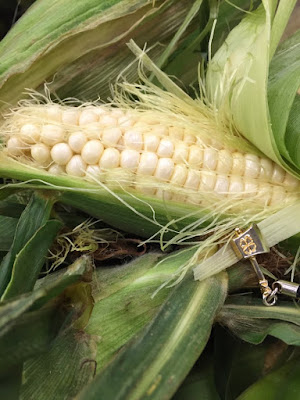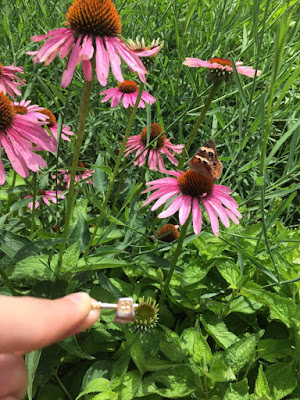Monday, August 10, 2015
25. Tropism
24. Pollen
This is a picture of a flower. A flower has pollen. In the picture the pollen is the yellow powder located in the middle of the flower. Pollen is a powdery substance, usually yellow in color, that consists of microscopic grains, that contain gametes, from the male part of a flower. Since the grains contain gametes pollen that's transported by wind, insects, and other animals can fertilize the female ovule. Pollen is also a source of many allergies in the spring time.
23. Radial Symmetry (animal)
This is a picture of a starfish. This is an example of radial symmetry. Radial symmetry occurs when an organism can be divided equally about a central point kind of like a pizza cut into equal parts. The symmetry can be divided any number of planes. If the starfish was cut using a four piece plane then all the cut pieces would be equal. Other examples of organisms with radial symmetry include: jellyfish, sea urchins, coral polyp. etc.
22. r Strategist
This is a picture of fish. Fish are r strategists. R strategists, also referred to as r-selected species, are species whose populations are controlled by their biotic potential. When compared to a K-strategist r strategists have a short life, rapid growth, early maturity, many small offspring, and little parental care or protection. R-selected species tend to be smaller than K-selected species. Examples of r strategists include: fish, mice, oysters,etc.
21. Population
This is a picture of people. The people in the picture are an example of a population. Population is all the organisms of the same group or species that live in a specific geographical area and are able to breed. The picture is of a group of the same species, human, that are able to interbreed, and in the geographical area of Yorktown, VA.
20. Pollinator
This is a picture of a bee, on a flower, pollinating. The bee is an example of a pollinator. A pollinator is an agent that transfers pollen from the anther of a flower to the stigma of a flower. There are many differents kinds of pollinators such as bee, birds, insects, etc. This relationship between the bee and the flower is also an example of mutualism because both the flower and bee benefit.
19. Mutualism
This is a picture of a clownfish in as sea anemone. This is an example of a symbiosis relationship that is mutualistic. Mutualism is where both the clownfish and sea anemone benefit and are able to flourish through symbiosis. The clownfish, which is territorial, protects the sea anemone from other marine predators and in return the sea anemone provides the clownfish with a home. The clownfish is the only fish that does not get stung by the tentacles of the sea anemone. Another example of mutualism is the symbiotic relationship between a flower and a bee.
18. Long Day Plant
This is a picture of lettuce. Lettuce is an example of a long day plant. A plant is classified as a long day plant or a short day plant based on its photoperiodism, is the reaction of a plant to the length of day or night. Long day plants are plants that flower when exposed to more daylight than darkness. Example of long day plants include: lettuce, spinach, cabbage, etc.
17. Lichen
This is a picture of fungi and alga on a tree. Note that the lichen in the picture above is not the plant growing on the left side, but rather it is the light green, dark green, and yellow mix of fungi and alga. This is an example of a lichen. A lichen is a slow growing group of fungi and alga that usually form leaf like or branching growth on rocks, trees, and etc. Lichen have a mutualistic relationship with the tree or rock that they grow on which means that both the fungi and alga and tree/rock benefit. Fungi and alga can be seen as partners in crime who come together and form a lichen.
16. K Strategist
15. Gymnosperm Leaf
This is a picture of a pine tree leaf. A pine tree leaf is an example of gymnosperm leaf. Gymno in greek means "naked" and sperm in greek means "seed" thus gymnosperm literally translates to "naked seed". This is true because gymnosperms seeds are not enclosed in an ovary. Pine trees are conifers which are a specific group of gymnosperms. There are different types of gymnosperm leaves. For example, coniferophyta have leaves resembles needles or scales while cycadophyta leaves are large and frond - like. There are also other kinds of leaves too.
14. Gymnosperm Cone
This is a picture of a female pine cone. A pine cone is an example of a gymnosperm cone.Gymno in greek means "naked" and sperm in greek means "seed" thus gymnosperm literally translates to "naked seed". This is true because a gymnosperm is a vascular plant that's seeds are not enclosed in an ovary, but rather the seeds are in a cone such as the one seen in the above picture. Angiosperms are the opposite of gymnosperms and have seeds that are enclosed in an ovary. Most gymnosperms consist of cone bearing trees or shrubs. Some examples of gymnosperm cones are conifer cones, cycad cones, ginkgo cones, etc.
13. Genetically Modified Organism
This is a picture of seedless grapes. This is an example of a genetically modified organism because the grapes were genetically modified to be seedless. A genetically modified organism, also referred to as GMO. is an organism whose genetic code has been altered by artificial means such as interspecies gene transfer. Some examples of GMO include fruits like the grapes shown above, GM atlantic salmon, and Enviropig. GMOs are developed for many reasons and a few being that they are more pest resist or that they have no seeds and make it easier to eat.
12. Flower Ovary
This is a picture of a flower ovary. In the picture above the flower's ovary is located near the bottom of the the slit. An ovary is part of the female reproductive organ in a flower and is also the part of the pistil that holds the ovules. The ovary is usually located above the sepals, below the sepals, or in line with the sepals and the base of the petals. Some flower ovaries are easier to see than others.
11. Fermentation
This is a picture of fermented vegetables. Fermentation is the process of a complex substance chemically breaking down into a simpler substance. The process usually involves bacteria, yeast, or other microorganisms for breakdown. Fermentation is used make wine,beer, yogurt, kimchi, and other foods; nevertheless fermentation also occurs in nature. An example of natural fermentation is when fruits go bad.
10. Eukaryote
This is a picture of grass. Grass is eukaryotic. A eukaryote is an organism with cells that contain a nucleus and other organelles that are enclosed within a membrane. All living organisms are eukaryotes with the exception of eubacteria and archaebacteria, and all multicellular organisms are eukaryotes. Grass, algae, pine tree, goldfish, dogs, and most animals and plants are all eukaryotic.
9. Endotherm
This is a picture of a horse. A horse is endothermic. An endotherm, also known as a warm - blooded animal, is an animal who is capable of internal regulation of body heat. This means that the animal does not have to depend on its environment to maintain its body temperature, but rather it can regulate and maintain its own body temperature. Mammals and birds are endothermic. Some examples of endothermic animals are horses, bears, elephants, peacocks, etc.
8. Ectotherm
This is a picture of a tortoise. A tortoise is an example of an ectotherm. An ectotherm, also called a cold-blooded animal, is an animal whose body temperature depends on external sources of heat. For example, sunlight and a heated rock surface are both external sources of heat. Ectotherms include reptiles, fish, amphibians, and invertebrates. Some examples of ectotherms are tortoises, lizards, catfish, turtles, frogs, ect.
6. CAM Plant
This is a picture of a pineapple. A pineapple is an example of a CAM plant. CAM, short for crassulacean acid metabolism, is a form of photosynthesis that plants in arid regions adapted to. A plant that uses CAM shuts its stomata during the day and during the night opens its stomata to take in carbon dioxide. This proves to be efficient for plants such as cacti, agave, pineapple, orchids and others that live in arid conditions.
5. C4 Plant
This is a picture of corn. Corn is a C4 plant. C4 plants are more efficient than C3 plants when in hot, dry climates. This is due to the fact that during the Calvin cycle, the process which plants take in CO2 and convert it into glucose for energy, C4 plants make four-carbon molecules and C3 plants make two three-carbon molecules. This allows plants such as corn, sugarcane plants, witchgrass, and others to thrive in hot, dry climates.
Sunday, August 9, 2015
4. C3
This is an example of a plant. This plant is an example of a C3 plant. C3 plants are the most common types of plants and also the most efficient at photosynthesis. These type of plants are best in cool, wet climates. If the stomata is open for plants in hot, dry areas it is dangerous because the plants lose water; however, C3 plants leave their stomata open during the day and are able to maintain water. C3 plants include most everyday plants. Some examples are evergreen trees, weedy plants, deciduous trees, and the plant above.
Saturday, August 8, 2015
3. Bilateral Symmetry
This is a picture of a butterfly. A butterfly is a perfect example of an insect with bilateral symmetry. An organism has bilateral symmetry if the left and right side of the organism, when divided in half, mirror each other. For example, when you vertically divide a butterfly both the sides look the same including the colors and design on its wings, therefore; a butterfly has bilateral symmetry.
2. Autotroph
This a picture of a plant. A plant is an example of an autotroph. An autotroph, also known as a producer, is an organism that synthesizes its own food from inorganic substances through the use of light or chemical energy. The prefix auto means "self ", and the root troph means "one who feeds" thus an autotroph is one that self feeds or makes its own food through chemical processes.
1. Animal That Has a Segmented Body
This is a picture of a worm. The worm represents an animal with a segmented body. A segmented body is a body that is divided into successive meta-meres or segments. The body has three segments: the head, the thorax, and the abdomen. Segmentation allows organisms to perform advanced functions involving movement. Examples include worms, ants, flies, lobsters, etc.
Subscribe to:
Comments (Atom)
























